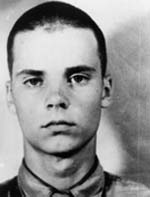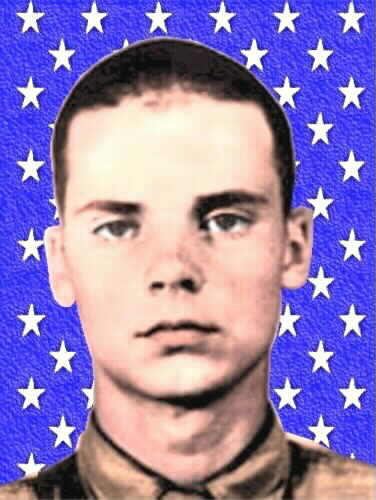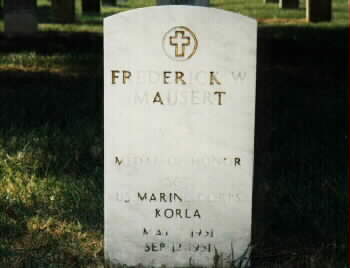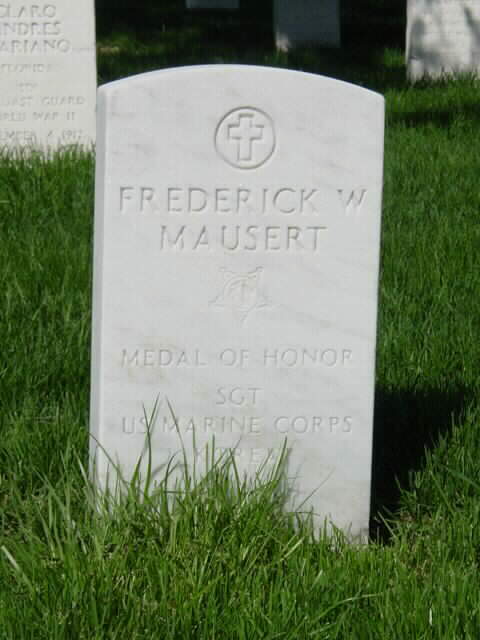Awarded the Medal of Honor for sacrificing his life in repated acts of heroism during the Korean Conflict. The nation’s highest decoration for valior was awarded to the youthful Marine for extraordinary heroism on September 12, 1951 at Songnap-yong, Korea, where he was killed-in-action while leading an assault on enemy positions. He was the 20th Marine to receive the Medal while serving in Korea.
Born on May 2, 1930 at Cambridge, New York, he lived in Dresher, Pennsylvania, before enlisting in the Marine Corps, June 21, 1948. Following recruit training at Parris island, South Carolina, he was stationed at Cherry Point and Camp Lejeune, North Carolina, before going to Korea, where he participated in campaigns in South and Central Korea.
In addition to the Medal of Honor, he was awarded the Purple Heart, a gold star in lieu of a second Purple Heart, the Good Conduct Medal, the Korean Service Medal with one gold star, and the United Nations Service Medal. He was a Sergeant with Company B, 1st Battalion, 7th Marines, 1st Marine Division at the time of his death.
He was subsequently buried in Section 12 of Arlington National Cemetery.
Photo Courtesy of the United States Marine Corps
Photo Courtesy of the Home of Heroes
MAUSERT, FREDERICK W., III
Rank and organization: Sergeant, U.S. Marine Corps, Company B, 1st Battalion, 7th Marines, 1st Marine Division (Rein.) Place and date: Songnap-yong, Korea, 12 September 1951. Entered service at: Dresher, Pennsylvania. Born: 2 May 1930, Cambridge, New York.
Citation:
For conspicuous gallantry and intrepidity at the risk of his life above and beyond the call of duty while serving as a squad leader in Company B, in action against enemy aggressor forces. With his company pinned down and suffering heavy
casualties under murderous machine gun, rifle, artillery, and mortar fire laid down from heavily fortified, deeply entrenched hostile strongholds on Hill 673, Sgt. Mausert unhesitatingly left his covered position and ran through a heavily mined and fire-swept area to bring back 2 critically wounded men to the comparative safety of the lines. Staunchly refusing evacuation despite a painful head wound sustained during his voluntary act, he insisted on remaining with his squad and, with his platoon ordered into the assault moments later, took the point position and led his men in a furious bayonet charge against the first of a literally impregnable series of bunkers. Stunned and knocked to the ground when another bullet struck his helmet, he regained his feet and resumed his drive, personally silencing the machine gun and leading his men in eliminating several other emplacements in the area. Promptly reorganizing his unit for a renewed fight to the final objective on top of the ridge, Sgt. Mausert boldly left his position when the enemy’s fire gained momentum and, making a target of himself, boldly advanced alone into the face of the machine gun, drawing the fire away from his men and enabling them to move into position to assault. Again severely wounded when the enemy’s fire found its mark, he still refused aid and continued spearheading the assault to the topmost machine gun nest and bunkers, the last bulwark of the fanatic aggressors. Leaping into the wall of fire, he destroyed another machine gun with grenades before he was mortally wounded by bursting grenades and machine gun fire. Stouthearted and indomitable, Sgt. Mausert, by his fortitude, great personal valor, and extraordinary heroism in the face of almost certain death, had inspired his men to sweep on, overrun and finally secure the objective. His unyielding courage throughout reflects the highest credit upon himself and the U.S. Naval Service. He gallantly gave his life for his country.
MAUSERT, FREDERICK WILLIAM III
- SGT USMC
- VETERAN SERVICE DATES: Unknown
- DATE OF BIRTH: 05/02/1931
- DATE OF DEATH: 09/12/1951
- DATE OF INTERMENT: 01/03/1952
- BURIED AT: SECTION 12 SITE 5559
ARLINGTON NATIONAL CEMETERY
Michael Robert Patterson was born in Arlington and is the son of a former officer of the US Army. So it was no wonder that sooner or later his interests drew him to American history and especially to American military history. Many of his articles can be found on renowned portals like the New York Times, Washingtonpost or Wikipedia.
Reviewed by: Michael Howard




